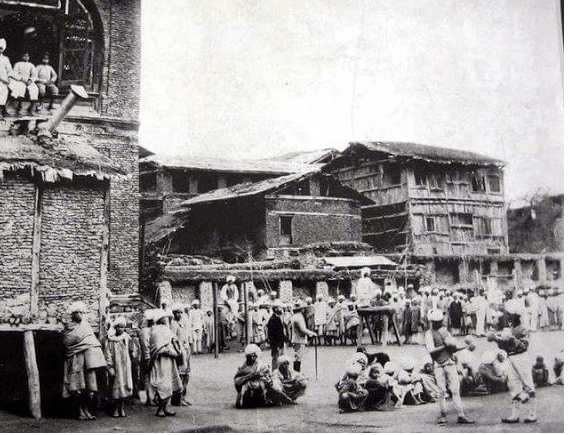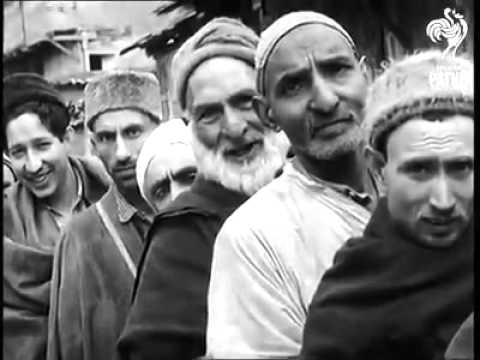“Ganai were fully knowledgeable about Kashmir/in wisdom and intelligence they were masters of the time”
Sir Walter Lawrence, who was the Settlement Commissioner in Kashmir for five years (1889-1894), writes in his famous book The Valley of Kashmir (1895, p.306): “The whole subject of Kashmir Krams [surnames] is fraught with difficulty, and this is increased by the fact that men of low occupations are arrogating high-sounding names. Thus of late years the Dums of Kashmir have steadily assumed the Kram of Ganai, much to the annoyance of the original Ganais. To make matters worse, the gardeners and butchers have also taken a fancy to the Kram name Ganai.”
While Lawrence mentions that Ganais were believed to be converted Brahmins, he does not dwell much on the subject. For example, he does not tell us why was Ganai high-sounding title, or why some people took a fancy to the name, or in what ways it became a vehicle for upward social mobility for some people?
However, a fuller picture about the Ganai social group emerges in Muhammad Din Fauq’s 900-page book Tarikh-i-Aqwam-i-Kashmir (History of the people of Kashmir), where he details the historical origins of the Ganai title and its social and cultural significance in Kashmir.
Below I have translated the section about Ganais from the 2015 edition of the book. The Persian words used in it (such as verses and quotes) were first translated into Urdu by Dr Nisar Ali Suufi (Tarbiyat Mudaris University, Tehran), and his Urdu translation was later rendered into English by this author.
***
Muhammad Din Fauq, Tarikh-i-Aqwam-i-Kashmir (Lahore: Zafar Brothers, 1934)
Ganai (pp. 290-93)
About Ganai, the author of Tareekh Aazmi writes: “At the time, from writers to magistrates to patwari [revenue officials] all would use this title.”
These words are recorded in the biography of Baba Usman Uchhap Ganai, who was a colleague of Hazrat Sheikh Noor-ud-din Wali, and has died during the time of Badshah. From these lines, it emerges that this title or nickname was in vogue even before Badshah. It’s written in Tareekh-i-Hassan: “Ganai in Persian means a cleric/writer.”
And when we take a look at the long list of famous scholars and renowned saints of Ganai lineage, this group is indeed found truly deserving of this title. That’s why this verse is famous about the Ganai clan in Kashmir:
Ganai ba Kashmir daana buud/khuda wand tadbeer wakh ama buud
[Ganai were fully knowledgeable about Kashmir/in wisdom and intelligence they were masters of the time.]

The author of Tahreekh-e-Hassan writes: “Ganai clan was basically from the Brahmin caste, they were men of rank and high posts.” However, if Ganai is the same title and nickname, then how can only Brahmins be deserving of this title or epithet. Someone from other communities also worthy of it might’ve been granted this title by the ruler of the time. For example, about Sheikh Yaboob Sarfi Ganai, it’s written in Tareekh-i-Aazmi, Tareek-i-Kabeer Kashmir, and other histories of Kashmir (in fact in Tareekh-i-Hassan itself) that he was from the family of Bayazid Aasmi, and the children and grandchildren of Bayazid Hazrat Aasim Hazrat Umar (R.A). And, Sheikh Yaqoob Sarfi had seven brothers and all seven had numerous descendants. And, all their progenies were called Ganai. Shayiq, who was a famous poet during the reign of Raja Sukh Jivan [1754-62], has also written only about their virtues. Here are a few verses of him:
[This person’s lineage traces back to Sheikh Hassan/his title was from the highly esteemed in Kashmir
This sinner’s title was Ganai/ and then the great Lord opened the gates of mercy for him
In their Valley Ganai were wise and intelligent/and then through Usman’s intercession they became friends of the cave.]
So, in the Ganai class are included those Muslims who came from abroad, and those aged men/chiefs [shayuukh] are also in Kashmir who converted to Muslims from Kashmiri Brahmins and other Hindu groups. Sheikh Yaqoob Sarfi was the son of Mir Hassan Ganai, who was the son of Bayazid Aasmi. As though Bayazid Aasmi came to Kashmir first. According to the author of Tareekh-i-Gulshan-i-Kashmir, Bayazid was given the title of Ganai, because he was a great calligrapher and a brilliant writer. Ganai means a literary person.
In Kashmir, Ganai is categorised into four classes. One, those who’re from the children of Hazrat Aasim bin Hazrat Umar Farooq (RA). Second, those people who were Syed or Mughal or Pathan or Qureshi, and were bestowed this title and then their progenies were also called Ganai. Third, those newly converted Muslims, including Brahmin, Kshatriya and Vaishya. Fourth, those Ganai, who work as meat-sellers.
For the first three classes of Ganai, there’s no need for elucidation—their meanings are becoming evident by itself. About the meat-seller Ganais, the author of Tareekh-i-Hassan writes: “Halmat Ganai was the name of a well-known person of that time, who was pious, and considered the occupation of cattle rearing and meat selling as a matter of pride and blessing.”
In short, since that time, a group from this clan has been trading in meat and identifying itself as Halmat Ganai caste. But, presently meat traders of Kashmir are not only from the descendants of Ganai clan or Halmat Ganai. Rather, based on the research of this author, among the meat traders of Kashmir include Kaul, Bhat, Dar, Chak, and a few other castes. And, engaged in the meat trade, they are all named as Ganai.
These days, in certain places of Kashmir, people working as government-appointed watchmen are also known as Ganai. If it’s true that they’re indeed from the Ganai clan only, it appears that through the passage of time when their erstwhile influence faded away, some of them might’ve adopted the occupation of the watchman.

Histories are a witness that Ganai has been Kashmir’s celebrated scholarly class. The author of Tareek-i-Hassan writes: “Often among them were renowned saints and grandees.” Khawaja Muhammad Aazam writes in his book: “Many of their children and descendants remained engaged in learning and erudition.” Some of them include Baba Usman Uchap Ganai, Sheikh Yaqoob Sarfi Ganai, Sheikh Baba Dawood Khaki Ganai, Haji Mulla Feroz Ganai, Mulla Abdul Wahab Ganai, Mulla Mohsin Ganai Faani (the teacher of Ustad Gani Malik Al-Ashraiye), Sheikh Abdul Wahab Noori bin Khawaja Rashid Ganai, Sheikh Ahmad Taraballi, Sheikh Hassan Lalu, Mulla Haji Jouhar Ganai, Maulana Shangraf Ganai, Sheikh Muhammad Tayyib Ganai, Mulla Muhammad Muraad Ganai (the son of Mehmood Ashraf bin Mulla Shams-ud-Din Ganai), Mulla Hussain Ganai, among others.
These were the people about whose learning and erudition and piety and devotion Kashmir will always be proud. The detailed accounts of these noblemen are registered in the histories of Kashmir. Some members of the Sheikh Yaqoob Sarfi’s family also live in Tral, and from the same family some time ago Abdul Ali Ganai, penname Aashiq, was a first-rate poet of Kashmiri and Persian. The famous Kashmiri poet of the contemporary times Peerzada Ghulam Ahmad Mehjoor is the disciple of Aashiq Trali.
The well-known religious scholar of Srinagar Mulla Inayat Allah Shawl and the wealthy landlord Khawaja Sanaullah Shawl were also Ganai. And, they belonged to the clan that came to Kashmir from Turkistan or Khurasaan [present-day Afghanistan]. Khawaja Saad-ud-din Shawl is from their progenies. A detailed account about them must be recorded in the section about Shawl clan.
Also, a respectable family from Ganai clan lives in village Machh Bhoon (Mattan), Islamabad. During the reign of late Maharaj Pratap Singh, a well-known member of this family, Qadir Ganai, has been on Tehsildar post. Sir Walter Lawrence had also given him a certificate for his services and familial respectability. The construction of Baba Baam-ud-din Bomzoor’s shrine was the result of his efforts. He died in 1953 bikrami [1897 AD].
In the 1891 census, the population of Ganai clan was 7987. And, it was registered as the Brahmin cultivator group. But, this author has already mentioned that Ganai were not Brahmins only, rather this clan includes a few other groups as well. In 1911, this same clan had a population of 46,424 in the Jammu and Kashmir province. And, in 1931, the population is now 59, 241, with 22,441 males and 26,800 females. Some families of this clan are also in Lahore and other places.
Muhammad Tahir is recent PhD graduate from Dublin City University, Ireland. His articles have appeared in RTE, The Japan Times, The Caravan, The Express Tribune, Kindle Magazine, Cafe Dissensus, Asia Dialogue, and in different newspapers and magazines in Kashmir.
Like this story? Producing quality journalism costs. Make a Donation & help keep our work going.








